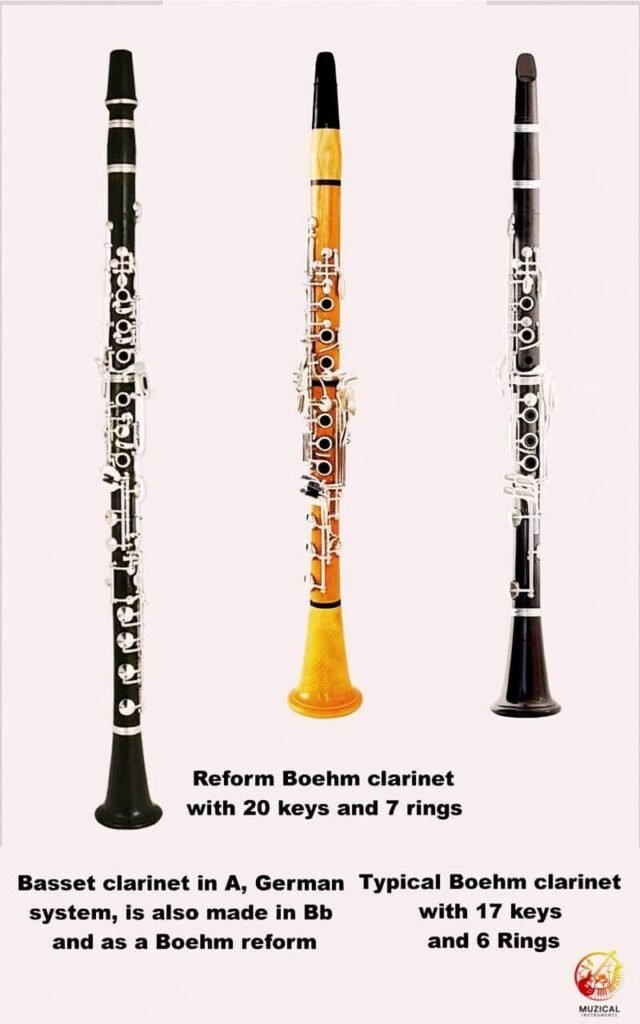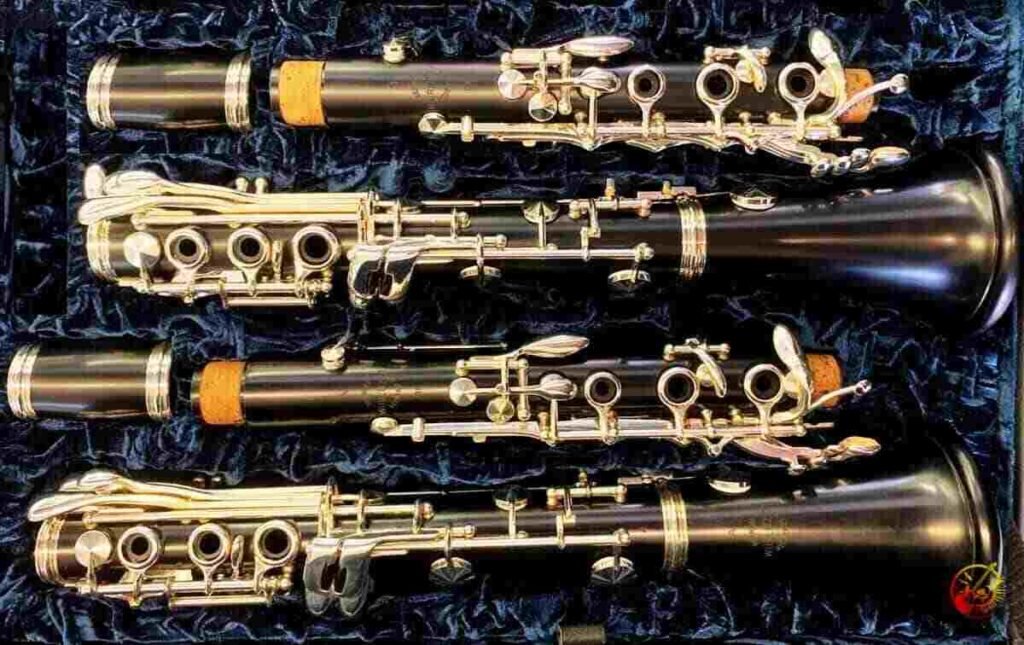What is the Reform Boehm Clarinet? A Complete Guide
The Reform Boehm clarinet is a special instrument designed to solve a problem that has puzzled clarinet players for over a century.
For years, the clarinet world has been split into two main camps: players who use the common French Boehm system and those in Germany and Austria who must use the German Oehler system. These aren’t just different brands; they’re entirely different instruments in how you play them and how they sound.
The Reform Boehm is the clever solution that builds a bridge between these two traditions.
In this guide, you’ll find out
- What is the Reform Boehm Clarinet?
- where this unique clarinet came from
- what makes it sound so special
- who should think about playing one, and
- why it might be the key to unlocking the sound you’ve been searching for.
What’s the big deal with French vs. German clarinets?
To really get why the Reform Boehm is so cool, you first have to understand the two instruments it’s based on.
Think of the French Boehm and German Oehler systems like two different types of cars. Both get you where you need to go, but they feel and handle completely differently.
The French Boehm system is the one you see almost everywhere. If you played clarinet in school, this is the system you learned. Developed in the 1840s, its keywork is smart, comfortable for the hands, and pretty easy to learn.
Its internal shape, or bore, is fairly wide, which helps give it a bright, clear, and powerful sound. Big names like Buffet Crampon and Selmer have perfected this design, making it the standard across the globe for orchestras, jazz, and solo playing.
Over in Germany and Austria, they prefer the German (Oehler) system. This system has more keys and a much trickier fingering system. More importantly, its acoustic design is different. The bore is narrower, and the tone holes are shaped in a special way.
This gives the German clarinet a darker, warmer, and more focused tone color, full of rich, velvety sounds. It’s the signature sound of famous groups like the Berlin Philharmonic.
The problem? If you learned on a Boehm clarinet, you can’t just pick up an Oehler and play it. You’d have to relearn how to play from scratch. The Reform Boehm clarinet was invented to fix this exact issue.

At a Glance Comparison of Clarinet Systems
| Feature | French Boehm System | German (Oehler) System | Reform Boehm Clarinet |
|---|---|---|---|
| Fingering System | Easy to learn; global standard. | Complex; requires special training. | Exactly the same as the French Boehm. |
| Bore Design | Wider and simpler bore shape. | Narrower and more complex bore. | Narrow, German-style bore. |
| Sound | Bright, clear, and flexible. | Dark, warm, and focused. | A mix: Dark and focused with a touch of Boehm flexibility. |
| Mouthpiece | Uses a French-style mouthpiece and reed. | Uses a German-style mouthpiece and reed. | Must use a German-style mouthpiece and reed. |
| Who Uses It? | Most players worldwide. | Mainly players in German and Austrian orchestras. | Players who want a German sound with easy Boehm keys. |
So, what is the Reform Boehm Clarinet?
The Reform Boehm clarinet is a brilliant mashup of the best parts of both systems. The idea was brought to life by a famous German instrument maker named Fritz Wurlitzer back in the 1940s. He noticed that many players loved the easy to use Boehm keys but needed to create the dark sound of a German clarinet to blend in with orchestras there. His solution was simple in concept but genius in execution: keep the outside of the clarinet familiar, but completely change its insides.


When you hold a Reform Boehm clarinet, your fingers will feel right at home. All the keys are in the same places as a standard Boehm system clarinet. You don’t have to relearn any scales or fingerings.
The real magic is in the acoustic properties of the instrument. Wurlitzer and other master makers who followed him, like his son Herbert Wurlitzer and the workshop Schwenk & Seggelke, built the instrument with the soul of a German clarinet.
Here’s how they do it:
- A Narrower Bore: The tube on the inside of the clarinet is skinnier and shaped differently. This is the biggest reason for the change in sound, as it focuses the air and creates a darker tone.
- Special Tone Hole Undercutting: The inside of each tone hole is carefully carved at an angle. This technique, called undercutting, helps tune the notes and adds to the instrument’s warm sound.
- A German Mouthpiece: You have to use this clarinet with a German-style mouthpiece and reed. This setup provides the right kind of resistance and is a key ingredient in making the authentic sound.
So, you get to play with the easy keywork you already know while producing a sound that fits right in with the German clarinet tradition.
Pro Tip: It’s All About the Bore
While we often focus on keys and mouthpieces, the bore is the true heart of a clarinet’s sound. Just a tiny change in its internal shape can completely change how the instrument plays and sounds. The Reform Boehm is the perfect example of this. It proves that the sound comes more from the column of air inside the instrument than from the keys you press on the outside.
Does it actually sound different?
Yes, it sounds very different, and anyone who knows clarinets can spot it right away. The point of the Reform Boehm clarinet isn’t to be a perfect copy of an Oehler clarinet, but to get very, very close. The result is a beautiful sound that sits somewhere between the French and German styles.
Compared to the standard Buffet or Selmer you might be used to, the sound is:
- Darker: The bright, shiny edge of the French sound is replaced with a rounder, warmer quality.
- More Focused: The sound feels tight and centered, not wide and spread out. This helps it blend perfectly with other woodwind instruments.
- Richer: You can hear more complex layers in the sound, especially in the low notes. It has a smooth, resonant texture that’s very pleasing to the ear.
But it’s not just a one trick pony. Compared to a full German clarinet, the Reform Boehm often has a little more flexibility, which is a nice feature from its Boehm heritage. This makes it a great choice for playing all kinds of music, not just German orchestral pieces. The whole system, the bore, the tone holes, and the mouthpiece has to work together to create this special sound.
Why It Sounds Different
| Acoustic Part | What’s Different on a Reform Boehm | How It Changes the Sound |
|---|---|---|
| Bore Shape | It’s narrower than a French Boehm. | Creates more air resistance, which helps focus and darken the sound. |
| Tone Holes | They are carved differently on the inside. | This helps with intonation (playing in tune) and makes the sound warmer. |
| Mouthpiece & Reed | Requires a specific German-style setup. | This setup is needed to control the focused air and produce the signature dark tone. |
Is the Reform Boehm Clarinet hard to play?
This is a really important question for anyone thinking about getting one. The answer is yes and no. The fingerings are easy, but making a good sound takes more effort.
The good news is that your fingers won’t have to learn anything new. The keywork is the same as any other Boehm clarinet, so you can pick it up and play your favorite music right away. This is the biggest selling point of the Reform Boehm clarinet.

The hard part is the breath control. Because of the narrower bore and German mouthpiece, the instrument has more resistance. It feels a bit like blowing through a smaller straw. You can’t be lazy with your air; you need a strong, steady, and focused stream of air to make the instrument sing.
Many players find they need to firm up their embouchure (the way they hold their mouth on the mouthpiece) and really support the sound from their diaphragm. The intonation can also be a little trickier. You have to listen carefully and adjust your pitch more often than on some modern clarinets. It’s not harder to move your fingers, but it is harder to produce a beautiful, controlled, and in-tune sound.
Who makes these clarinets, and what do they cost?
You won’t find a Reform Boehm clarinet in your average music store. These are high end, professional instruments made by expert craftspeople, mostly in Germany.
The most famous maker is Wurlitzer, a family run company that is considered the best of the best. Another top maker is Schwenk & Seggelke, known for their amazing craftsmanship. These clarinets are a serious investment. Because they are handmade by masters, they cost a lot of money, often much more than a standard professional clarinet.
You usually have to order one directly from the maker and may have to wait months or even years for it to be built. Finding a used one is possible, but they are rare and don’t lose their value. The Reform Boehm clarinet is a true piece of art, and it’s priced like one.
Final Thoughts
So, what is the Reform Boehm clarinet? It’s much more than just a different model of clarinet. It’s a brilliant solution that brings two very different traditions together. It gives players the chance to create that dark, rich German sound without having to learn a completely new and difficult fingering system.
It’s the perfect example of how an instrument can be changed to help artists make the exact music they want to make.
If you’re a serious clarinet player who loves that warm, orchestral sound, the Reform Boehm is definitely worth looking into. The best way to start is by listening.Find recordings of players who use them and see if you like the sound.
You can also try a German style mouthpiece on your current clarinet to get a small taste of what it feels like.
The Reform Boehm clarinet might just be the perfect instrument to help you find your unique voice.
FAQ: What is the Reform Boehm Clarinet
1. What is the main advantage of a Reform Boehm clarinet?
The biggest advantage is that it gives a player the dark, rich, and focused sound of a German Oehler-system clarinet while using the familiar, ergonomic fingering system of the French Boehm clarinet. This means you don’t have to spend years learning a completely new way to play to achieve that specific orchestral tone. It’s the best of both worlds: German sound with Boehm keys.
2. Can I use a German mouthpiece on my regular French Boehm clarinet?
Yes, you can, and it’s a great way to experiment! Using a German mouthpiece and reed on your standard Boehm clarinet will give you a taste of the increased resistance and help darken your sound. However, it won’t turn your instrument into a Reform Boehm. The true magic of the Reform Boehm clarinet comes from its specialized narrow bore and undercut tone holes, which work in harmony with the German mouthpiece to produce its unique character.
3. Why do orchestras in Germany and Austria prefer a darker clarinet sound?
This preference is deeply rooted in musical tradition. The darker, warmer tone of the German-style clarinet is considered ideal for blending with other woodwinds like bassoons and horns. This sound concept became the standard for romantic-era German composers like Brahms and Wagner, and the tradition has continued. The focused tone helps create a cohesive and rich orchestral texture rather than a soloistic one.
4. Are Reform Boehm clarinets only for professional orchestral players?
While they are most common among professionals playing in or auditioning for European orchestras, they are not exclusively for them. Any serious player, including advanced students, university music majors, or dedicated amateurs, who loves that warm, focused sound can benefit from a Reform Boehm clarinet. It’s more about the specific sound you want to create than the job title you hold.
5. What makes a clarinet’s sound “dark” or “bright”?
A clarinet’s tone color is mainly determined by its internal design, or bore. A “bright” sound, typical of French Boehm clarinets, comes from a wider cylindrical bore that allows the sound to be powerful and spread out. A “dark” sound comes from a narrower, more complex bore, like that found in German and Reform Boehm instruments. This focuses the air column, reduces certain high-frequency overtones, and creates a warmer, more centered tone. The mouthpiece and reed setup also play a crucial role in refining this sound.
6. Is it difficult to switch from a standard Boehm to a Reform Boehm clarinet?
The switch has two parts. The easy part is your fingers, the keywork is identical, so there is no new fingering system to learn. The challenging part is your breath and embouchure. A Reform Boehm clarinet has more resistance and requires much stronger, more focused air support to play in tune and produce a beautiful sound. It’s less forgiving than a standard clarinet, so it demands more discipline from the player.
